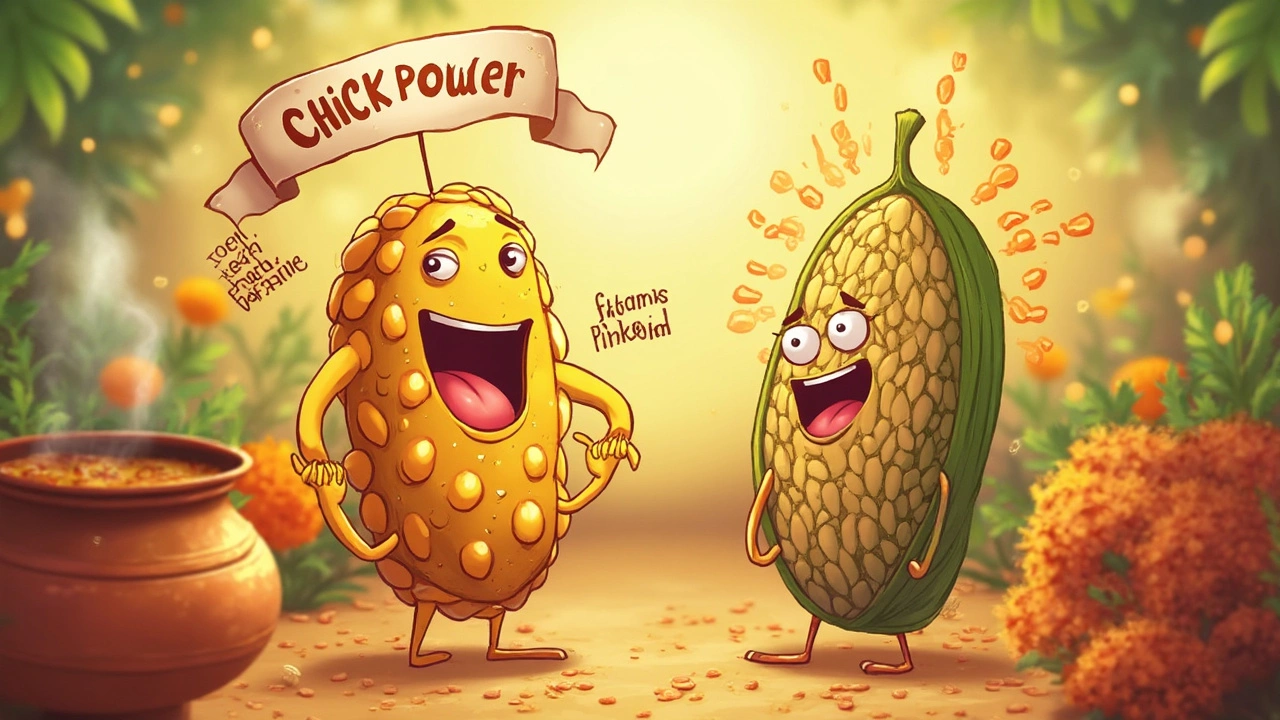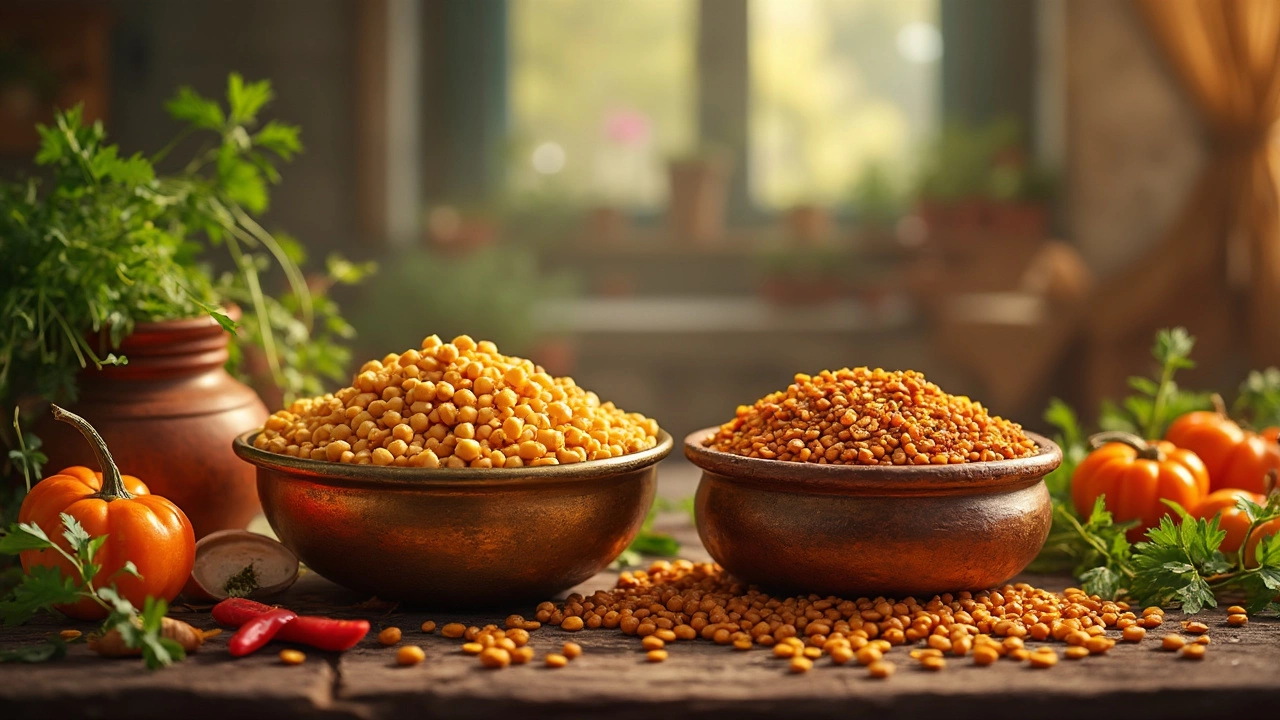So, you're standing in the grocery aisle, trying to decide between chickpeas and lentils for your next meal. It's not an easy choice, right? Both are great in a dal, and they each bring something special to the table. Let's start with the basics: chickpeas and lentils are fantastic sources of protein and fiber, which make them perfect pals for a balanced diet.
You might be wondering: what's the key difference? Well, chickpeas, also known as garbanzo beans, are packed with fiber and have a slightly nutty taste. On the other hand, lentils come in various colors, like green, red, and brown, and they're a bit quicker to cook. Each type of lentil brings its unique flavor and texture, offering endless variety.
If you're keeping an eye on your iron intake, lentils might be your new best friend. They're excellent for those looking to boost iron without munching on meat. Chickpeas, while still good, aren't as high in iron but make up for it with other nutrients. Thinking about cholesterol? Chickpeas have been shown to help keep it in check, thanks to their fiber content.
- The Nutritional Rundown
- Health Benefits Unpacked
- Culinary Flexibility
- Which is Easier to Cook?
- Budget and Sustainability
- Simple Dal Recipe Ideas
The Nutritional Rundown
Alright, let's dig into the nitty-gritty of what makes chickpeas and lentils such nutritional powerhouses. They might look unassuming, but these legumes are brimming with goodness that’s hard to ignore, especially if you're aiming for a healthier diet.
Starting with calories, both options are great for a low-cal diet. A half-cup of cooked lentils has about 115 calories, while chickpeas clock in at around 135 calories for the same serving size. Not a big difference, but still worth noting if you're counting.
How about protein? Lentils edge out slightly ahead, offering about 9 grams per half-cup serving. Chickpeas come in close with 7 grams. That makes both a fantastic choice for anyone looking to up their protein intake without resorting to meat.
Don’t forget the fiber! Chickpeas are the real winner here, packing about 6 grams of fiber in each half-cup. Lentils aren't far behind with about 8 grams. Fiber is your best friend if you're looking to keep things 'moving,' if you catch my drift.
If vitamins and minerals are your thing, both legumes deliver a hefty dose. Lentils are rock stars in the folate department, providing a big chunk of your daily needs. Chickpeas shine with their magnesium and potassium content, both crucial for keeping your body's engine running smoothly.
Let’s take a look at a quick comparison:
| Nutrient | Chickpeas (per 1/2 cup cooked) | Lentils (per 1/2 cup cooked) |
|---|---|---|
| Calories | 135 | 115 |
| Protein (g) | 7 | 9 |
| Fiber (g) | 6 | 8 |
| Folate (% of RDI) | 35 | 45 |
Whatever you're looking for—fiber, protein, or specific nutrients—both options make a strong case for adding them to your meals. Whether it's a hearty dal or a fresh salad, these legumes fit right in, bringing both flavor and nutrition to your plate.
Health Benefits Unpacked
When it comes to picking between chickpeas and lentils, it helps to dig into what they actually bring to your health game. Both are incredible nutrient powerhouses, each with its own perks.
Chickpeas are famous for their fiber—a great friend to your gut, helping keep things, well, moving along smoothly. Not just that, but they’re a solid source of protein if you’re looking to cut back on meat without missing out on essential amino acids. Plus, the presence of folate and manganese does wonders for your body, supporting metabolism and bone health.
On the flip side, lentils are no slouch. They come loaded with folate, vital for making DNA and other genetic material. Also, they’re a top choice if you’re skimping on red meat, thanks to their iron content. This is especially helpful for energy levels and keeping fatigue at bay. Lentils also pack B vitamins, which are key in converting food into energy. If you have a keen eye on blood pressure, potassium in lentils helps keep it in check.
Now, here's a handy comparison to highlight some key nutrients:
| Nutrient | Chickpeas (per 100g) | Lentils (per 100g) |
|---|---|---|
| Protein | 19g | 9g |
| Fiber | 7.6g | 7.9g |
| Iron | 2.9mg | 3.3mg |
| Folate | 557µg | 180µg |
In the end, both options are heart-healthy and can help manage weight due to their low-calorie, high-satiety properties. So, whether you're stirring up a simple dal or looking for a fiber-rich meal, adding these legumes to your diet can really pack a punch in terms of health benefits.
Culinary Flexibility
When it comes to making delicious meals, both chickpeas and lentils are stars in their own right. They're like that friend who's always down for anything. Seriously, these legumes can fit into almost any cuisine, giving you a ton of options.
Let's start with chickpeas. These guys are super versatile. You can roast them for a crunchy snack, toss them into salads for a protein boost, or blend them with some garlic and lemon juice to make hummus. They even find their way into sweet treats, like chickpea blondies. For meals, think beyond the can—try making a comforting chickpea stew or curry.
Lentils are no less flexible. They're perfect for hearty soups and stews, and they absorb flavors really well. With a good simmer, they turn into a creamy dal, especially when you mix them with spices like turmeric and cumin. Lentils can be added to burgers for a plant-based twist or even tossed into a salad for a filling lunch.
Since legume recipes often call for simmering or slow cooking, let's quickly compare how they fare in the kitchen:
| Legume | Cooking Time |
|---|---|
| Chickpeas (canned) | Ready to eat |
| Chickpeas (dried) | 1-2 hours (or overnight soak) |
| Red Lentils | 15-20 minutes |
| Green/Brown Lentils | 30-45 minutes |
The cooking time can influence your choice, especially when you're in a rush or have little patience for kitchen marathons. Canned chickpeas are a quick fix, while lentils, particularly the red ones, offer a faster option from scratch. Whether it's a busy weekday dinner or a lazy Sunday lunch, one of them will fit the bill.

Which is Easier to Cook?
When it comes to cooking, both chickpeas and lentils have their personal quirks. You probably know that time is a big factor here. Lentils are the sprinters of the legume world—they don't need soaking and usually cook in about 20-30 minutes, depending on the type.
On the flip side, chickpeas are more like marathon runners. They've usually got to sit in water for 8 hours or overnight before they're ready for the pot. Once that's done, they still take about an hour of cooking to get tender. Some folks also use canned chickpeas to skip this step when they're in a hurry, but that means missing out on the flavor you get from cooking them fresh.
Here's the cool part: lentils absorb flavors super well, making them perfect for quick dishes like soups or stews. Try adding spices like turmeric, cumin, and garlic while they cook, and you'll have a delicious base in no time. Chickpeas might take longer, but they're awesome for slow-cooked meals that soak up all those yummy spices over time, like certain types of dal.
If you're curious to see the differences laid out, here's a little comparison table:
| Nutrient | Chickpeas | Lentils |
|---|---|---|
| Preparation Time | 8 hours soak | No soak needed |
| Cooking Time | 1 hour | 20-30 mins |
| Commonly Paired Spices | Cumin, coriander | Turmeric, garlic |
When you're planning a meal, think about your time and what flavors you want to highlight. Whether you choose chickpeas or lentils, you're setting yourself up for a tasty, nutritious treat!
Budget and Sustainability
Alright, let's talk about money and the planet. When it comes to your wallet, both chickpeas and lentils are pretty easy on the budget. You can usually snag a bag of either for just a couple of pounds, making them a steal compared to pricier proteins like meat or fish. Plus, they last ages in your pantry, so you're not going to feel the waste if you take a while to use them up.
Now, what about sustainability? Here's where both of these legumes shine. Growing lentils uses less water compared to other crops, and they actually help enrich the soil with nutrients, making them a fab option for eco-friendly farming. Chickpeas aren't far behind either—they're considered a low-impact crop, meaning they don't require loads of resources to cultivate.
Switching to a legume-based diet, even if it's just once or twice a week, can significantly reduce your carbon footprint. According to a study by researchers at Oxford University, cutting down on meat and dairy could shrink an individual's food carbon footprint by up to 73%. That's a massive shift with a seemingly simple change.
In terms of transport emissions, buying locally grown legumes is a sweet spot for being more sustainable. Plus, purchasing in bulk at your local market not only cuts down on packaging waste, but it's usually cheaper too!
Simple Dal Recipe Ideas
Cooking up a heartwarming bowl of dal is like giving yourself a hug from the inside. And the best part? You don’t need to be a Michelin-starred chef to make it happen. With chickpeas and lentils being the stars, these recipes are as wholesome as they are delicious.
Let's start with a lentil dal:
- Red Lentil Dal: Perfect for those new to making dal. Red lentils cook faster, saving you time in the kitchen. Simply rinse a cup of red lentils, boil them in two cups of water, and watch as they turn into a creamy, comforting base.
- Add some ginger, garlic, and turmeric for a health boost and sauté in oil with mustard seeds and cumin. Throw in chopped tomatoes and simmer until it smells amazing. Serve with rice or naan, and that's dinner sorted!
Craving chickpeas instead? Try this:
- Chickpea Dal: Start with soaked chickpeas or make it easy by using the canned ones. Sauté onion, garlic, and ginger until golden. Add a pinch of turmeric, garam masala, and cumin seeds—these spices will give your dal that Indian touch.
- Stir in the chickpeas and a can of coconut milk for a rich and creamy texture. Finish off with a squeeze of lemon and fresh coriander. It tastes divine with flatbread or over a bowl of steamy rice.
If you're up for it, try a mixed dal using both chickpeas and lentils. The combo offers the best of both worlds. Nutrient-packed, quick to whip up, and sure to please even the picky eaters at home.
And here’s a little bonus tip: Dal's forgiving. If your spice pantry is looking sparse, swap or skip spices as needed. It's all about making it work with what you've got.

